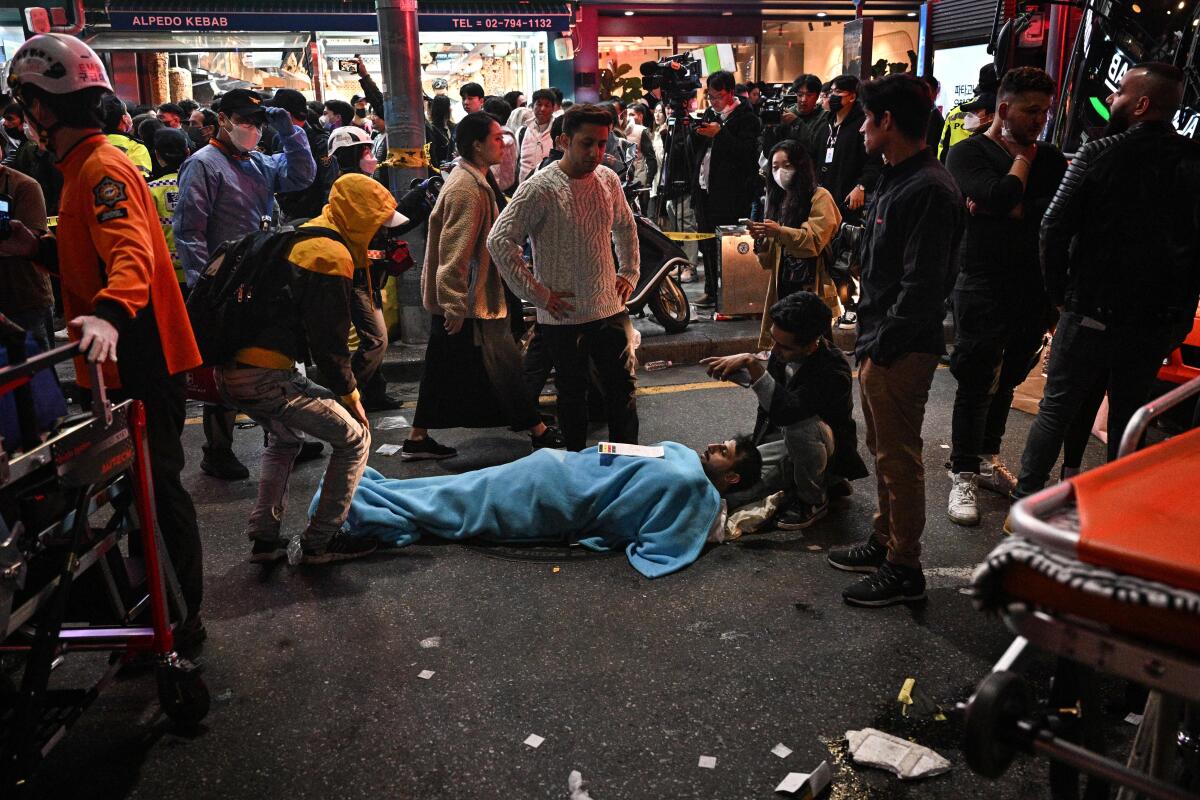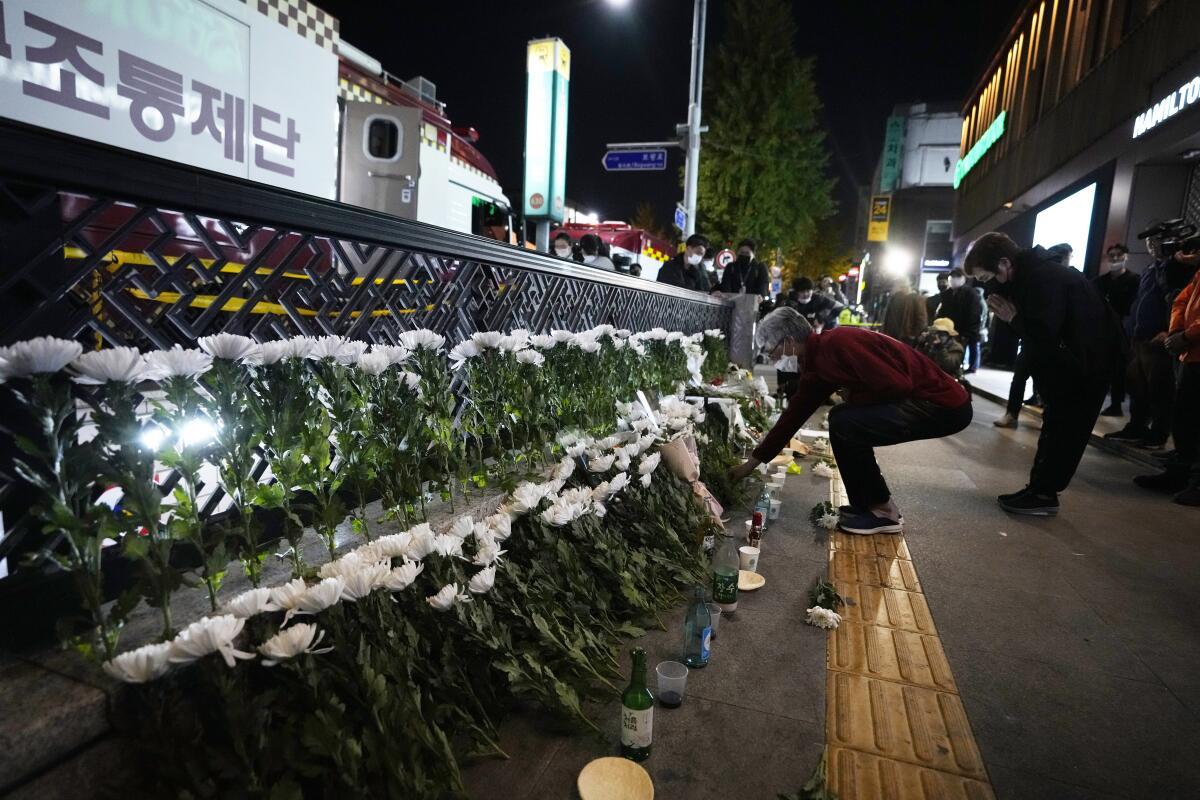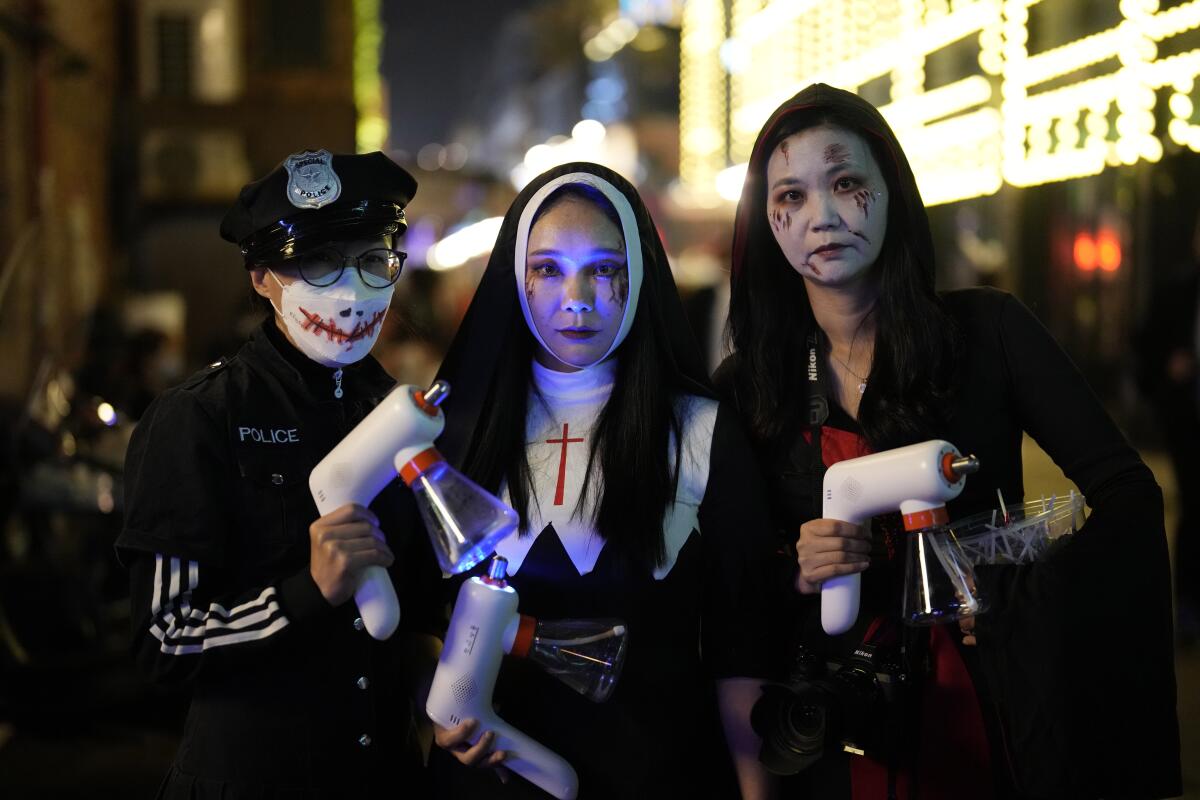How generational gap may have helped lead to South Korea’s Halloween tragedy

- Share via
In 2019, Hannah Lee, a college student from a suburb of Seoul, told her family that she was heading to the lively Itaewon neighborhood to celebrate Halloween.
Lee, now 23, was curious to see fellow young Koreans dressed as zombies. Elder family members were puzzled.
“All asked: Why?” she recalled. “They think it’s a foreign culture. It’s not even a Korean thing.”
Although she had thought of returning to Itaewon this Halloween weekend, remembering the size of the crowd along the narrow and often steep roads and stairways of the hip, hilly nightlife district was enough to swear off going again this year, the first since the height of the COVID-19 pandemic.

“When I heard 100,000 [were] coming, I thought it would be dangerous.”
Lee was one of the fortunate young Seoul residents who did not witness or fall victim to the horrors of the Seoul Halloween stampede Saturday night that resulted in the deaths of more than 150 partygoers, most of them in their 20s and 30s, and injured more than 130.
The dead, 98 of them women and at least four of them teenagers, were trapped and crushed in a crowd surge. At least 20 were foreigners from China, Russia, Iran and elsewhere. Two Americans were among those killed, the U.S. Embassy in Seoul tweeted Sunday morning.
President Biden warns that global hunger could rise after Russia halts a U.N.-brokered deal to allow safe passage for ships carrying Ukrainian grain.
Some witnesses and experts say that the cultural gap between a younger generation influenced by social media and Western traditions and their elders, some of whom outright sneer at such outside influence, may help explain why authorities failed to provide adequate security to help control the massive crowds that have taken to packing Itaewon, home of many of the most popular nightclubs and bars in Seoul, on the Halloween weekend.
“It’s the government negligence, especially from local authorities. There wasn’t ... ambulance duty. If you’re planning a party of 100,000 coming, you got to have ambulances, etc. There was none of that,” said Torsten Ingvaldsen, 28, a music business professional who survived the disaster. “This [party] is routine. This happens every October in Itaewon. It’s been happening for over a decade.”

The Seoul-based Hankyoreh newspaper reports that only 137 police officers were on the scene at Itaewon. For a BTS concert this month that attracted 55,000 to the city of Busan — about half the number that had been expected at Itaewon — some 1,300 police officers were assigned, in addition to 2,700 security officers, volunteers and others who controlled the crowd, according to a report from Newsis, a Korean news agency.
Minister of the Interior and Safety Lee Sang-min in a briefing Sunday, according to Hankyoreh, said more police would not have made a difference. He added that more officers were unavailable due to their monitoring protests elsewhere in the city.
Yet the number of police officers at Itaewon far paled compared with the thousands sometimes assigned to protests, said Alex Taek-Gwang Lee, a professor at Kyung Hee University.
“They thought the event at Itaewon isn’t as important, but the tragedy happened here,” Lee said. “Without considering and understanding the cultural and generational gap, public safety can be shaken.”
Halloween celebrations began gaining popularity in South Korea in the early 2000s, as more youngsters became familiar with the Western tradition while attending English-language schools and kindergarten. Such schools hired native English speakers from the United States and elsewhere, who taught trick-or-treat customs to Korean children. Itaewon, next to a longtime, now largely closed, major U.S. military base and still home to many foreign residents, seemed a natural place to go trick-or-treating, Lee said.
As these children became adults, social media platforms boosted Halloween’s popularity, with many sharing photos of themselves in costumes in Itaewon. Increasingly, online streamers also broadcast live from the streets, said Grace Shin, a reporter at Arirang TV in Seoul.

“More and more people are exposed to what’s happening during Halloween, and you’re seeing people in makeup and matching outfits,” Shin said. “You can pay $7 to get what looks like a big scar on your face. People would update their social media with #Itaewon or #ItaewonHalloween, which makes more people want to get it.”
Stacy Nam, who works as a producer in the entertainment industry, had gone to Itaewon every year for Halloween until around the mid-2010s. Unlike Christmas and Valentine’s Day, which are family- or couples-oriented, Halloween is a day when you can have fun with your friends, she said.
“Normally, strangers don’t make conversations with each other, but Itaewon being more of a Western environment, you feel more free to express yourself,” said Nam, who’s in her 30s. “It’s a different kind of energy than other hot spots in Seoul.”
By the mid-2010s, Nam said, she began venturing elsewhere for Halloween because Itaewon got so crowded. This year, she went to Apgujeong, a vibrant neighborhood on its own but less packed than Itaewon.
“When I look at the people going out — I’ve seen friends going to Itaewon — it was like, are you OK putting yourself through that?” Nam said.
But Nam is far from blaming those who went to Itaewon. The government knows, or should have known, that Itaewon on holidays is “crazy,” she said.
“Everyone is just really stunned at the loss of life, and how something like this could happen in an environment where overcrowding has been known to happen on this holiday for years,” she said. “Why was not more responsibility taken? Why wasn’t there extra manpower taken on hand?”
After all, the warning signs were there.
In 2019, a report from Seoul-based Hankook Ilbo was headlined: “Halloween Holy Land? How Itaewon’s Halloween Became ‘Hell.’”

“Couples showed up in Joker makeup. A man wore a North Korean military outfit. A family dressed as dinosaurs,” the report read. “By 9 p.m., Itaewon’s Halloween hit its climax. The narrow streets were so filled that walking was difficult. It took 30 minutes to walk 200 meters.”
In the wake of the tragedy, Nam cannot help but draw comparison to the Sewol ferry disaster in 2014, which killed more than 300 and drew Koreans’ anger toward what they saw as an inadequate response from their government
“You think there’s obviously a plan and action,” she said. “You are watching the tragedy that did not have to happen unfold.”
The Associated Press contributed to this report.
More to Read
Sign up for Essential California
The most important California stories and recommendations in your inbox every morning.
You may occasionally receive promotional content from the Los Angeles Times.












